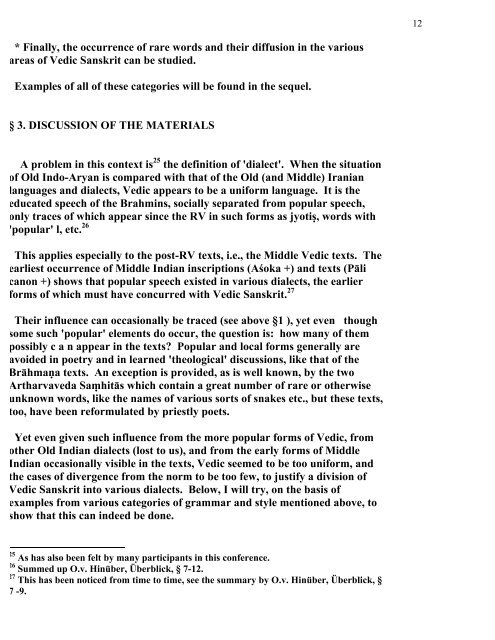TRACING VEDIC DIALECTS - People.fas.harvard.edu
TRACING VEDIC DIALECTS - People.fas.harvard.edu
TRACING VEDIC DIALECTS - People.fas.harvard.edu
Create successful ePaper yourself
Turn your PDF publications into a flip-book with our unique Google optimized e-Paper software.
* Finally, the occurrence of rare words and their diffusion in the various<br />
areas of Vedic Sanskrit can be studied.<br />
Examples of all of these categories will be found in the sequel.<br />
§ 3. DISCUSSION OF THE MATERIALS<br />
A problem in this context is 25 the definition of 'dialect'. When the situation<br />
of Old Indo-Aryan is compared with that of the Old (and Middle) Iranian<br />
languages and dialects, Vedic appears to be a uniform language. It is the<br />
<strong>edu</strong>cated speech of the Brahmins, socially separated from popular speech,<br />
only traces of which appear since the RV in such forms as jyotiṣ, words with<br />
'popular' l, etc. 26<br />
This applies especially to the post-RV texts, i.e., the Middle Vedic texts. The<br />
earliest occurrence of Middle Indian inscriptions (Aśoka +) and texts (Pāli<br />
canon +) shows that popular speech existed in various dialects, the earlier<br />
forms of which must have concurred with Vedic Sanskrit. 27<br />
Their influence can occasionally be traced (see above §1 ), yet even though<br />
some such 'popular' elements do occur, the question is: how many of them<br />
possibly c a n appear in the texts? Popular and local forms generally are<br />
avoided in poetry and in learned 'theological' discussions, like that of the<br />
Brāhmaṇa texts. An exception is provided, as is well known, by the two<br />
Artharvaveda Saṃhitās which contain a great number of rare or otherwise<br />
unknown words, like the names of various sorts of snakes etc., but these texts,<br />
too, have been reformulated by priestly poets.<br />
Yet even given such influence from the more popular forms of Vedic, from<br />
other Old Indian dialects (lost to us), and from the early forms of Middle<br />
Indian occasionally visible in the texts, Vedic seemed to be too uniform, and<br />
the cases of divergence from the norm to be too few, to justify a division of<br />
Vedic Sanskrit into various dialects. Below, I will try, on the basis of<br />
examples from various categories of grammar and style mentioned above, to<br />
show that this can indeed be done.<br />
25 As has also been felt by many participants in this conference.<br />
26 Summed up O.v. Hinüber, Überblick, § 7-12.<br />
27 This has been noticed from time to time, see the summary by O.v. Hinüber, Überblick, §<br />
7 -9.<br />
12
















